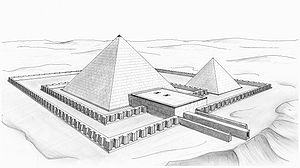Pyramid of Khendjer
[1] The pyramidion was discovered during excavations under the direction of Gustave Jéquier in 1929, indicating that the pyramid was finished during Khendjer's lifetime.
The main pyramid currently lies in ruins, due in part to the damaging excavations by G. Jéquier and now rises only about one meter above the desert sand.
The outer one, made of mudbrick, contained in the north-east corner a small subsidiary pyramid, the only one known dating to the 13th dynasty.
[1] A small chapel was built immediately adjacent to the north side of the main pyramid, inside the inner enclosure wall.
The core fared very badly with time and the pyramid now stands only one meter (3.3 feet) tall due to its disintegration.
A stairway with 13 steps leads to a chamber housing a large granite portcullis similar to those encountered in the Mazghuna pyramids, also dated from the Middle Kingdom.
[3] The block was carved into two compartments destined to receive the king's coffin, canopic chest and funerary goods.
[1] The mechanism for closing the vault consisted of sand-filled shafts on which rested the props of the northern ceiling slab.
Beyond is an antechamber branching to the north and south to two burial chambers lined with masonry and both housing a large quartzite coffer.
[1] Some unexpected turn of events probably prevented their use, although there is nothing directly suggesting that the king wasn't interred as planned in the main pyramid.
[6][7] However, in his 1997 study of the Second Intermediate Period, egyptologist Kim Ryholt concludes that Khendjer's successor, Imyremeshaw, usurped the throne.





